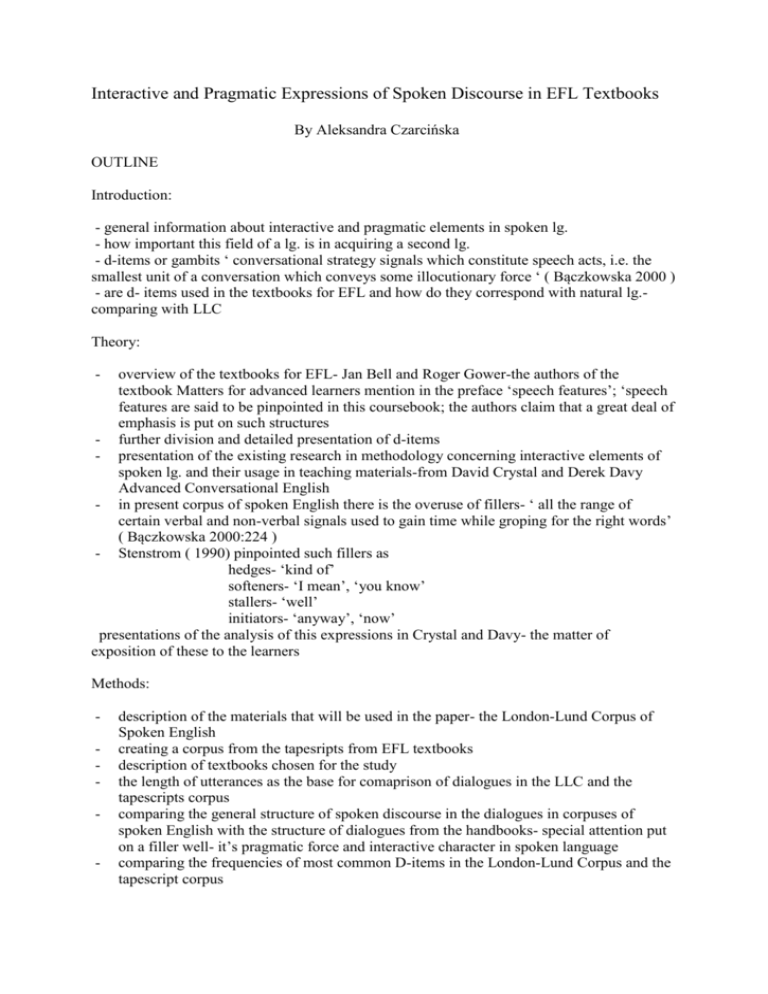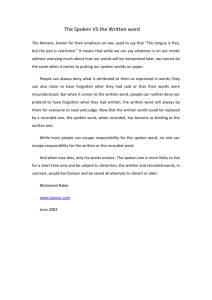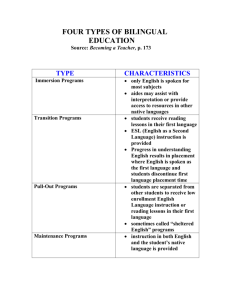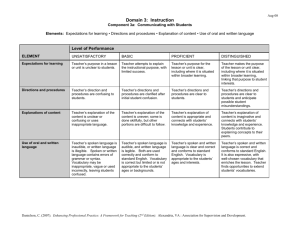Interactive and Pragmatic Expressions of Spoken Discourse in the
advertisement

Interactive and Pragmatic Expressions of Spoken Discourse in EFL Textbooks By Aleksandra Czarcińska OUTLINE Introduction: - general information about interactive and pragmatic elements in spoken lg. - how important this field of a lg. is in acquiring a second lg. - d-items or gambits ‘ conversational strategy signals which constitute speech acts, i.e. the smallest unit of a conversation which conveys some illocutionary force ‘ ( Bączkowska 2000 ) - are d- items used in the textbooks for EFL and how do they correspond with natural lg.comparing with LLC Theory: - overview of the textbooks for EFL- Jan Bell and Roger Gower-the authors of the textbook Matters for advanced learners mention in the preface ‘speech features’; ‘speech features are said to be pinpointed in this coursebook; the authors claim that a great deal of emphasis is put on such structures - further division and detailed presentation of d-items - presentation of the existing research in methodology concerning interactive elements of spoken lg. and their usage in teaching materials-from David Crystal and Derek Davy Advanced Conversational English - in present corpus of spoken English there is the overuse of fillers- ‘ all the range of certain verbal and non-verbal signals used to gain time while groping for the right words’ ( Bączkowska 2000:224 ) - Stenstrom ( 1990) pinpointed such fillers as hedges- ‘kind of’ softeners- ‘I mean’, ‘you know’ stallers- ‘well’ initiators- ‘anyway’, ‘now’ presentations of the analysis of this expressions in Crystal and Davy- the matter of exposition of these to the learners Methods: - - description of the materials that will be used in the paper- the London-Lund Corpus of Spoken English creating a corpus from the tapesripts from EFL textbooks description of textbooks chosen for the study the length of utterances as the base for comaprison of dialogues in the LLC and the tapescripts corpus comparing the general structure of spoken discourse in the dialogues in corpuses of spoken English with the structure of dialogues from the handbooks- special attention put on a filler well- it’s pragmatic force and interactive character in spoken language comparing the frequencies of most common D-items in the London-Lund Corpus and the tapescript corpus - conducting a questionnaire concerning interactive expressions among intermediate and advanced students Results and discussion - - conclusions drawn from the comparison the two kinds of corpuses about aims of listening exercises in the handbooks on the basis of comparison of frequencies of D-items in the LLC and in the tapescripts corpus checking to what extent the use of D-items are used by the authors of handbooks basing on the study of the use of fillers in discourse, checking whether context and uses are similar in both cases- the results: whether language in handbooks reflects naturalness of real spoken language discussion of the results of the questionnaire- what is the real use of interactive expressions among students and their attitude towards interactive expressions Conclusions - summing up of the theoretical and methodological parts of the paper suggestions for further studies in the field of spoken language- creating a corpus of EFL’s spoken English as the methodological tool for teachers and authors of syllabi and textbooks









